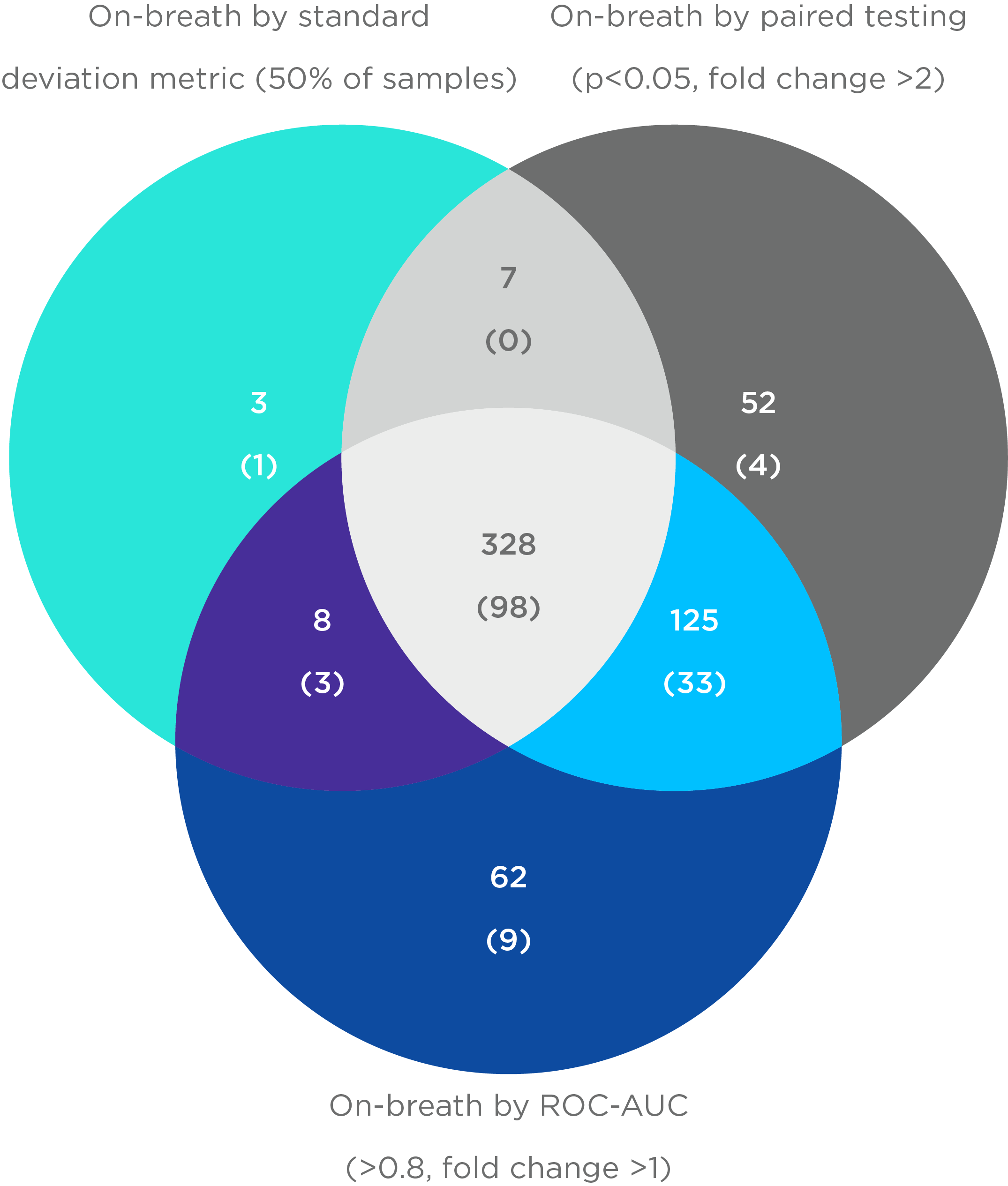What does ‘on-breath’ mean?
Published on: 20 Dec 2024
At Owlstone, we have been working on an exciting project to help the breath research community better understand the composition of volatile organic compounds (VOCs) in human breath. We have developed the Breath Biopsy VOC Atlas®, a catalog of identified and quantified VOCs that are ‘on-breath’. The Atlas also provides scientific context to the identified compounds from the literature and quantitative data, to enable the confident selection of candidate biomarkers for a variety of diseases, such as liver cirrhosis, asthma, and cancer.
VOCs can arise from endogenous processes such as lipid peroxidation and inflammation, or exogenous sources such as microbiome-originating metabolism, diet, and environmental exposure. These compounds are detectable in various sampling mediums such as blood, feces, urine, and exhaled breath. VOCs diffuse from their point of origin and travel through the bloodstream to the alveolar membrane, where they volatilize into the air in the lungs.
The compounds contained in the Atlas are ‘on-breath’, meaning they have undergone robust analytical comparison to background samples, to discriminate VOCs in the breath from background contaminant VOCs that have originated from the environment, or breath sampling equipment. But what exactly does ‘on-breath’ mean?
The development of the Breath Biopsy VOC Atlas®
In our recently published paper, ‘High-quality identification of volatile organic compounds (VOCs) originating from breath’, we discuss the process behind the development of the Atlas, and how we determined if compounds were on-breath. We used three metrics to compare VOCs in breath samples with paired system background samples. The three metrics we used were:
- The standard deviation (SD) metric. A VOC was considered on-breath if the concentrations exceeded the mean of the system background concentration plus 3 standard deviations in at least 50% of breath samples. This percentage can be altered to fit the purpose of the study. Additionally, if a VOC was observed in breath samples but not observed in less than 4 system background samples, it was automatically considered as being on-breath.
- The paired T-test metric. A VOC was considered on-breath if the paired breath and background samples were associated with a fold difference of ≥ 2 and a paired t-test one-tailed p-value of ≤ 0.05.
- The receiver operating characteristic area under the curve (ROC-AUC) metric. A VOC was considered on-breath if the fold difference between breath and background samples was > 1, and the calculated ROC-AUC value was ≥ 0.8.

Figure 1. A compound is “on-breath” when it has good signal to background. That means the quantity of a given VOC is higher in the breath sample when compared to a blank sample.
Each metric defines a VOC as on-breath with respect to the background samples in different ways. The three metrics were chosen to provide complimentary insights into the composition of on-breath VOCs. When combined into a panel of metrics, they may provide higher confidence to an on-breath identification.
We analyzed 90 healthy adult breath samples and paired system backgrounds using the Breath Biopsy OMNI® method. The three metrics were applied to identify the VOCs present in the breath at levels significantly above those in the system background and hence referred to as on-breath. Figure 1 shows the total number of on-breath VOCs that were identified using each of the 3 metrics. A total of 585 VOCs were identified as on-breath using any metric, and, of these, 56% were on-breath by all three metrics. The standard deviation (SD) metric was the most stringent, with 95% of the features identified as on-breath using this metric were also identified as on-breath by the other two metrics.

Figure 2. Venn diagram showing the numbers of VOCs classified as on-breath by each metric, along with the number of those VOCs that have been identified, in brackets.
On-breath meaning and our technology
Therefore, a VOC is on-breath when it can be confidently distinguished from background based on statistical or quantitative data.
VOCs that have entered the VOC Atlas have all been acquired from breath samples collected using Breath Biopsy® technology and analyzed using the Breath Biopsy OMNI platform.
Our ReCIVA® device pre-concentrates breath samples onto absorbent tubes which enables a larger collection of air volume, offering the potential for greater sensitivity in detecting low-abundance compounds. Our CASPER® Portable Air Supply provides a source of filtered clean air to industry standards for inhaled air, minimizing background VOC signals in breath samples. This ensures that the results are robust and collected and analyzed using a standardized protocol.
The Atlas has VOC data from over 100 diseases including cancer, asthma, and liver cirrhosis to provide a detailed understanding of human breath as a platform for biomarker analysis. This means the Atlas can support researchers and the wider breath research community through its search interface, and presents VOCs alongside their clinical, chemical, and biological context.
In our case study, we highlighted how the VOCs identified as being on-breath that are found in the Atlas can facilitate disease biomarker identification. The confirmed identities and on-breath status of VOCs, alongside the literature included in the Atlas, enable researchers to select biomarkers that can potentially distinguish malaria of different Plasmodium species, differentiate asymptomatic from symptomatic malaria or non-infected subjects, and monitor malaria treatment.
At the Breath Biopsy Conference 2024, Julia and Nabeetha from Owlstone Medical discussed building the VOC Atlas, and how it requires precise, accurate, and robust workflows for the quantification and chemical identification of VOCs on-breath. They also discuss how our Atlas project is being expanded and made public with support from key collaborative partners such as the FDA and the Bill and Melinda Gates Foundation.
We are beginning to make specific Atlas data accessible, and we aim to make the Atlas a rich repository of on-breath data for external researchers. You can sign up to receive access to the Atlas here.
